Corporate and Financial Accounting Report: JKY & FAB Limited
VerifiedAdded on 2021/02/20
|12
|3154
|46
Report
AI Summary
This report provides an executive summary of corporate and financial accounting, focusing on the equity accounting method and the consolidated accounting method. It advises a company to use the purchase method for a takeover, explains the applicability of various accounting standards (AASB 3, AASB 10, AASB 128), and summarizes intra-group transactions, analyzing their effect on profit and non-controlling interest (NCI). The report concludes that the company should adjust transactions by preparing a consolidated statement and highlights the disclosure requirements of consolidated financial information and NCI, emphasizing the importance of disclosing these statements to stakeholders for investment decisions. Finally, it outlines challenges faced by the company during the preparation of the consolidation statement, including intra-group transaction reconciliation, equity reconciliation, and historic elimination.
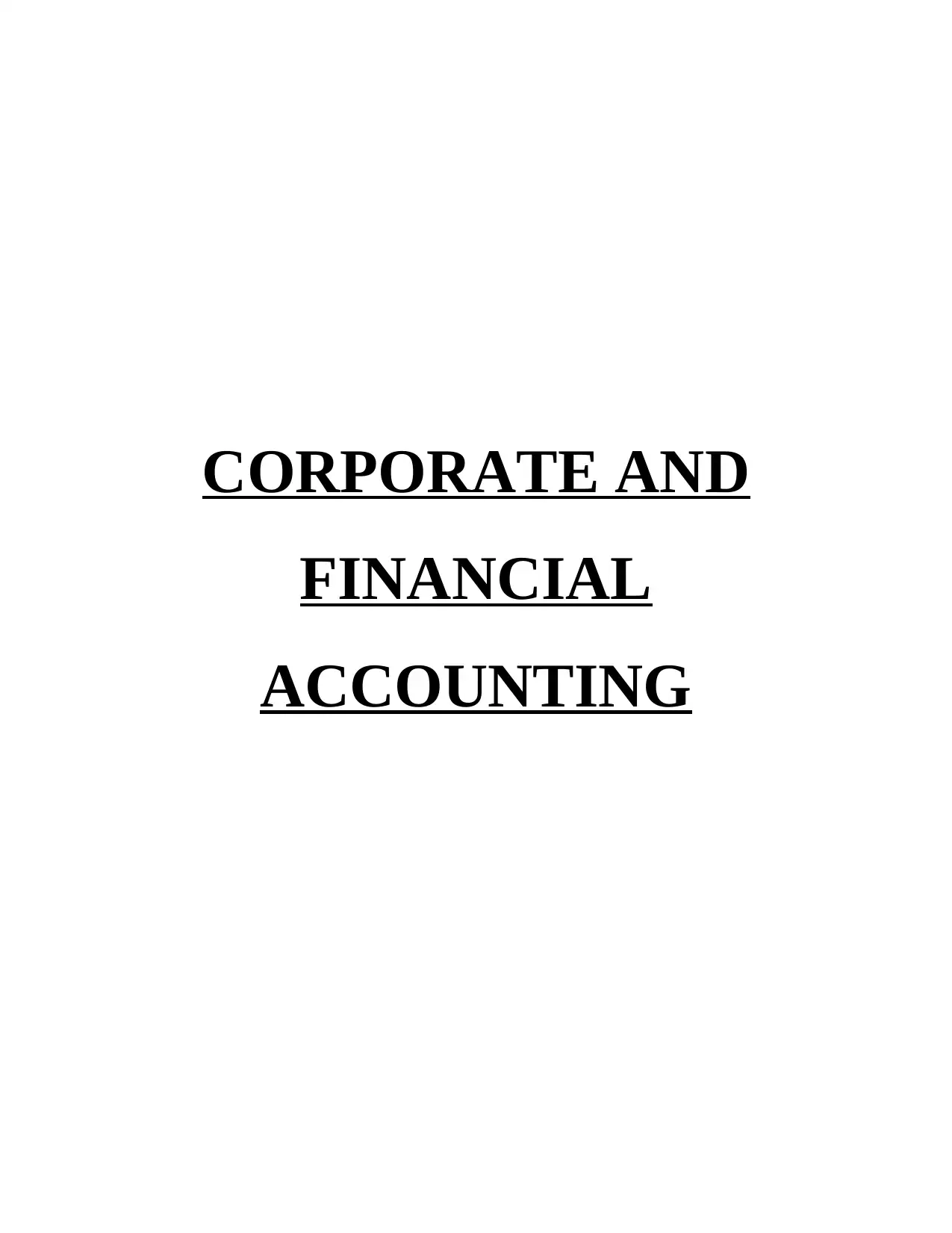
CORPORATE AND
FINANCIAL
ACCOUNTING
FINANCIAL
ACCOUNTING
Paraphrase This Document
Need a fresh take? Get an instant paraphrase of this document with our AI Paraphraser
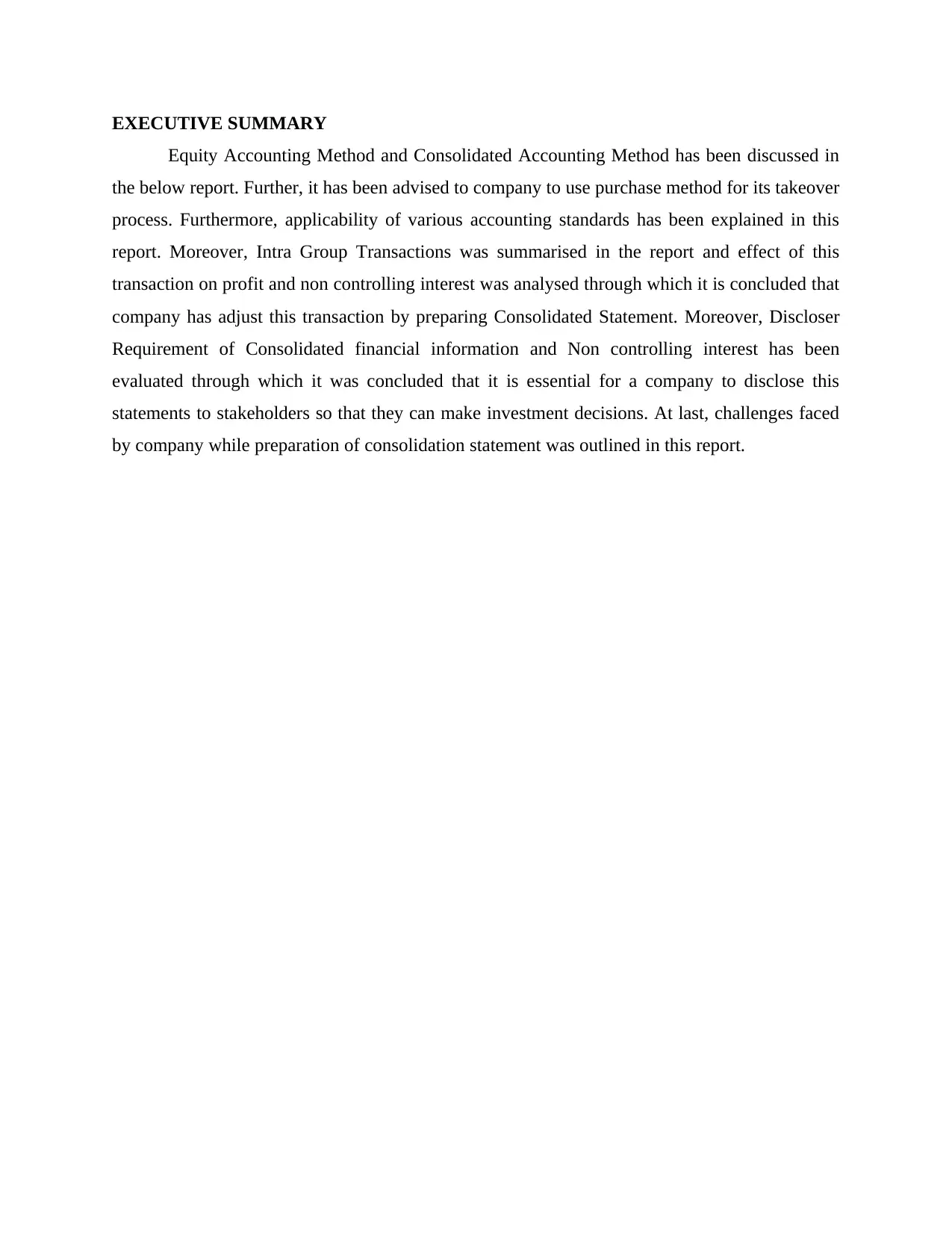
EXECUTIVE SUMMARY
Equity Accounting Method and Consolidated Accounting Method has been discussed in
the below report. Further, it has been advised to company to use purchase method for its takeover
process. Furthermore, applicability of various accounting standards has been explained in this
report. Moreover, Intra Group Transactions was summarised in the report and effect of this
transaction on profit and non controlling interest was analysed through which it is concluded that
company has adjust this transaction by preparing Consolidated Statement. Moreover, Discloser
Requirement of Consolidated financial information and Non controlling interest has been
evaluated through which it was concluded that it is essential for a company to disclose this
statements to stakeholders so that they can make investment decisions. At last, challenges faced
by company while preparation of consolidation statement was outlined in this report.
Equity Accounting Method and Consolidated Accounting Method has been discussed in
the below report. Further, it has been advised to company to use purchase method for its takeover
process. Furthermore, applicability of various accounting standards has been explained in this
report. Moreover, Intra Group Transactions was summarised in the report and effect of this
transaction on profit and non controlling interest was analysed through which it is concluded that
company has adjust this transaction by preparing Consolidated Statement. Moreover, Discloser
Requirement of Consolidated financial information and Non controlling interest has been
evaluated through which it was concluded that it is essential for a company to disclose this
statements to stakeholders so that they can make investment decisions. At last, challenges faced
by company while preparation of consolidation statement was outlined in this report.
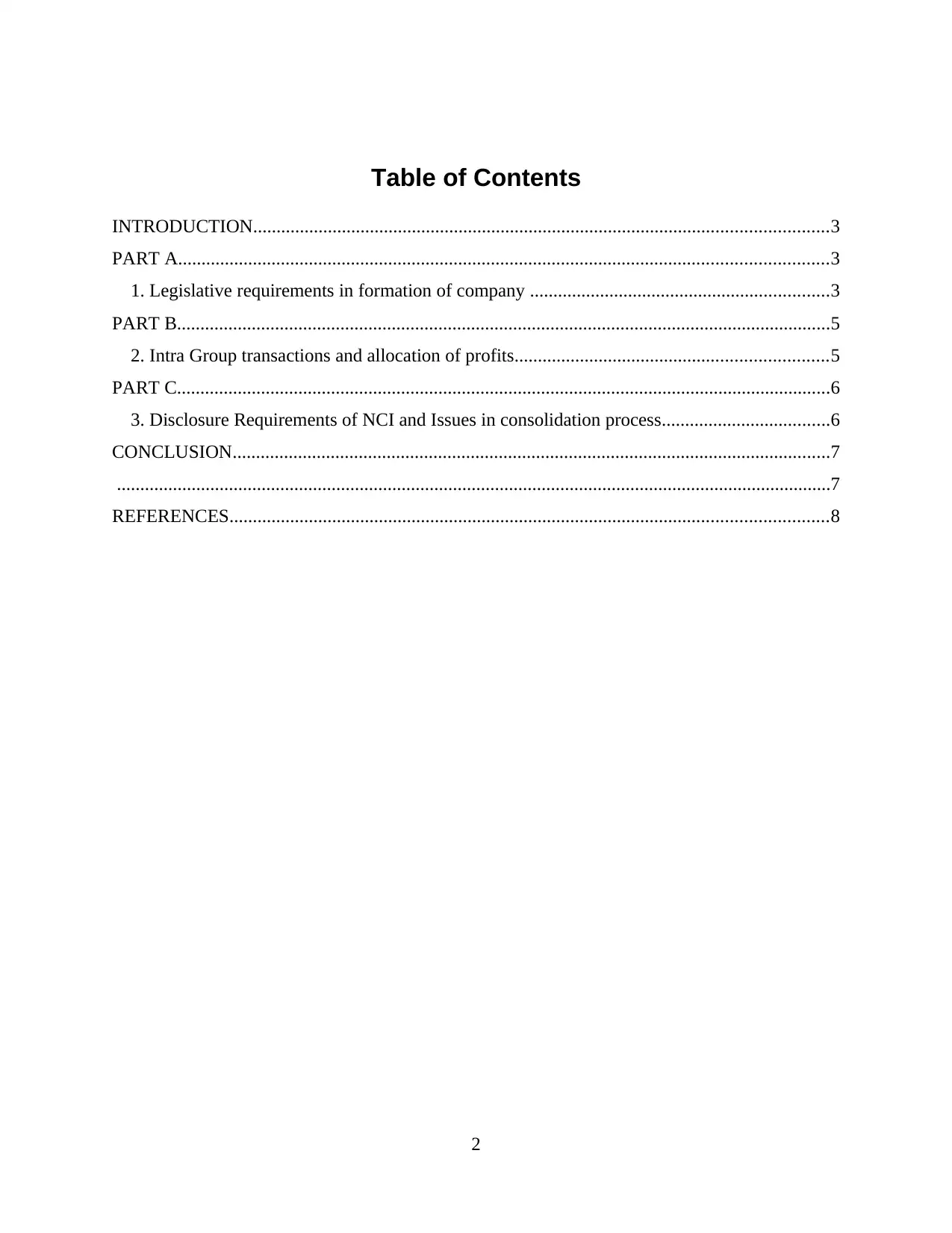
Table of Contents
INTRODUCTION...........................................................................................................................3
PART A...........................................................................................................................................3
1. Legislative requirements in formation of company ................................................................3
PART B............................................................................................................................................5
2. Intra Group transactions and allocation of profits...................................................................5
PART C............................................................................................................................................6
3. Disclosure Requirements of NCI and Issues in consolidation process....................................6
CONCLUSION................................................................................................................................7
.........................................................................................................................................................7
REFERENCES................................................................................................................................8
2
INTRODUCTION...........................................................................................................................3
PART A...........................................................................................................................................3
1. Legislative requirements in formation of company ................................................................3
PART B............................................................................................................................................5
2. Intra Group transactions and allocation of profits...................................................................5
PART C............................................................................................................................................6
3. Disclosure Requirements of NCI and Issues in consolidation process....................................6
CONCLUSION................................................................................................................................7
.........................................................................................................................................................7
REFERENCES................................................................................................................................8
2
⊘ This is a preview!⊘
Do you want full access?
Subscribe today to unlock all pages.

Trusted by 1+ million students worldwide
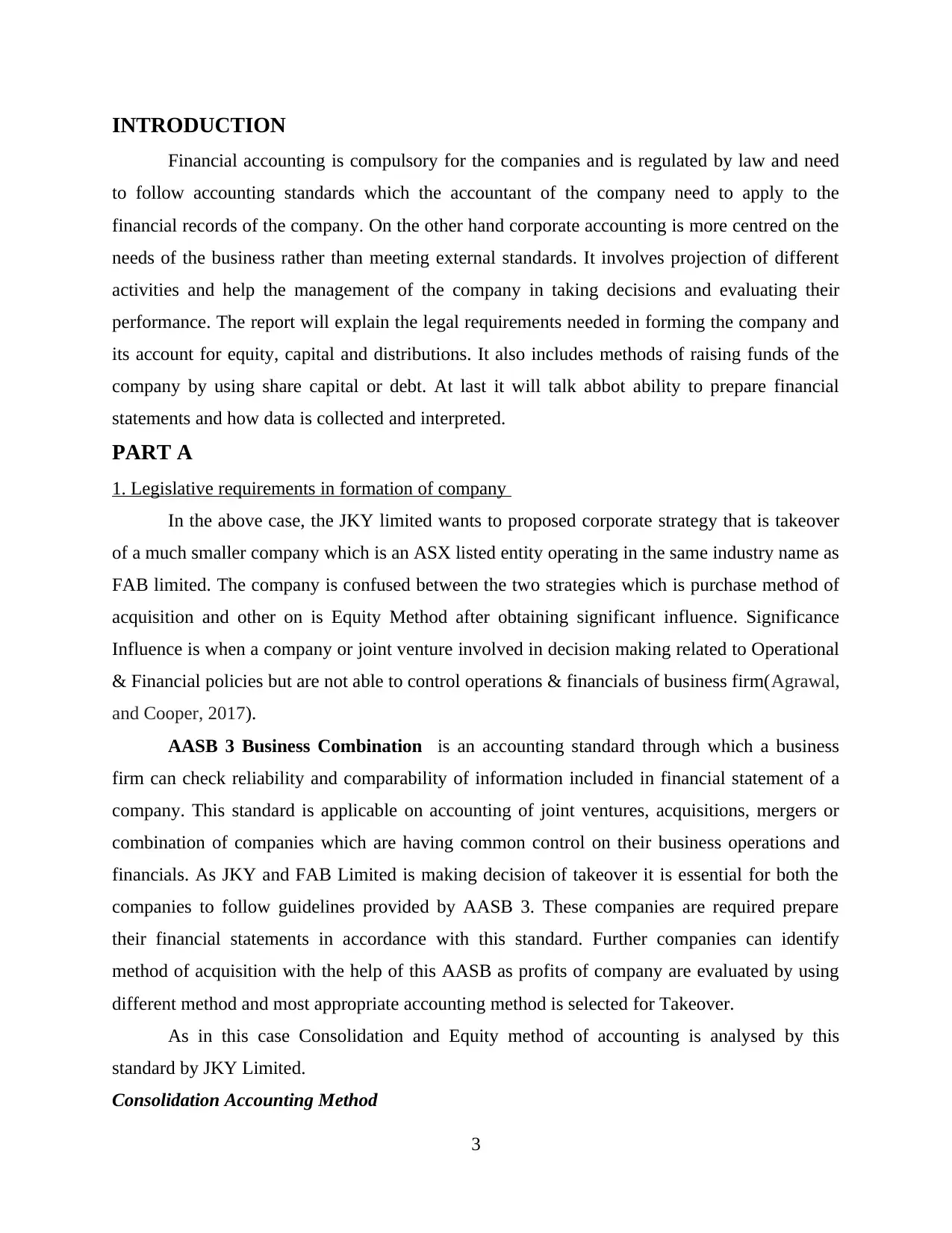
INTRODUCTION
Financial accounting is compulsory for the companies and is regulated by law and need
to follow accounting standards which the accountant of the company need to apply to the
financial records of the company. On the other hand corporate accounting is more centred on the
needs of the business rather than meeting external standards. It involves projection of different
activities and help the management of the company in taking decisions and evaluating their
performance. The report will explain the legal requirements needed in forming the company and
its account for equity, capital and distributions. It also includes methods of raising funds of the
company by using share capital or debt. At last it will talk abbot ability to prepare financial
statements and how data is collected and interpreted.
PART A
1. Legislative requirements in formation of company
In the above case, the JKY limited wants to proposed corporate strategy that is takeover
of a much smaller company which is an ASX listed entity operating in the same industry name as
FAB limited. The company is confused between the two strategies which is purchase method of
acquisition and other on is Equity Method after obtaining significant influence. Significance
Influence is when a company or joint venture involved in decision making related to Operational
& Financial policies but are not able to control operations & financials of business firm(Agrawal,
and Cooper, 2017).
AASB 3 Business Combination is an accounting standard through which a business
firm can check reliability and comparability of information included in financial statement of a
company. This standard is applicable on accounting of joint ventures, acquisitions, mergers or
combination of companies which are having common control on their business operations and
financials. As JKY and FAB Limited is making decision of takeover it is essential for both the
companies to follow guidelines provided by AASB 3. These companies are required prepare
their financial statements in accordance with this standard. Further companies can identify
method of acquisition with the help of this AASB as profits of company are evaluated by using
different method and most appropriate accounting method is selected for Takeover.
As in this case Consolidation and Equity method of accounting is analysed by this
standard by JKY Limited.
Consolidation Accounting Method
3
Financial accounting is compulsory for the companies and is regulated by law and need
to follow accounting standards which the accountant of the company need to apply to the
financial records of the company. On the other hand corporate accounting is more centred on the
needs of the business rather than meeting external standards. It involves projection of different
activities and help the management of the company in taking decisions and evaluating their
performance. The report will explain the legal requirements needed in forming the company and
its account for equity, capital and distributions. It also includes methods of raising funds of the
company by using share capital or debt. At last it will talk abbot ability to prepare financial
statements and how data is collected and interpreted.
PART A
1. Legislative requirements in formation of company
In the above case, the JKY limited wants to proposed corporate strategy that is takeover
of a much smaller company which is an ASX listed entity operating in the same industry name as
FAB limited. The company is confused between the two strategies which is purchase method of
acquisition and other on is Equity Method after obtaining significant influence. Significance
Influence is when a company or joint venture involved in decision making related to Operational
& Financial policies but are not able to control operations & financials of business firm(Agrawal,
and Cooper, 2017).
AASB 3 Business Combination is an accounting standard through which a business
firm can check reliability and comparability of information included in financial statement of a
company. This standard is applicable on accounting of joint ventures, acquisitions, mergers or
combination of companies which are having common control on their business operations and
financials. As JKY and FAB Limited is making decision of takeover it is essential for both the
companies to follow guidelines provided by AASB 3. These companies are required prepare
their financial statements in accordance with this standard. Further companies can identify
method of acquisition with the help of this AASB as profits of company are evaluated by using
different method and most appropriate accounting method is selected for Takeover.
As in this case Consolidation and Equity method of accounting is analysed by this
standard by JKY Limited.
Consolidation Accounting Method
3
Paraphrase This Document
Need a fresh take? Get an instant paraphrase of this document with our AI Paraphraser
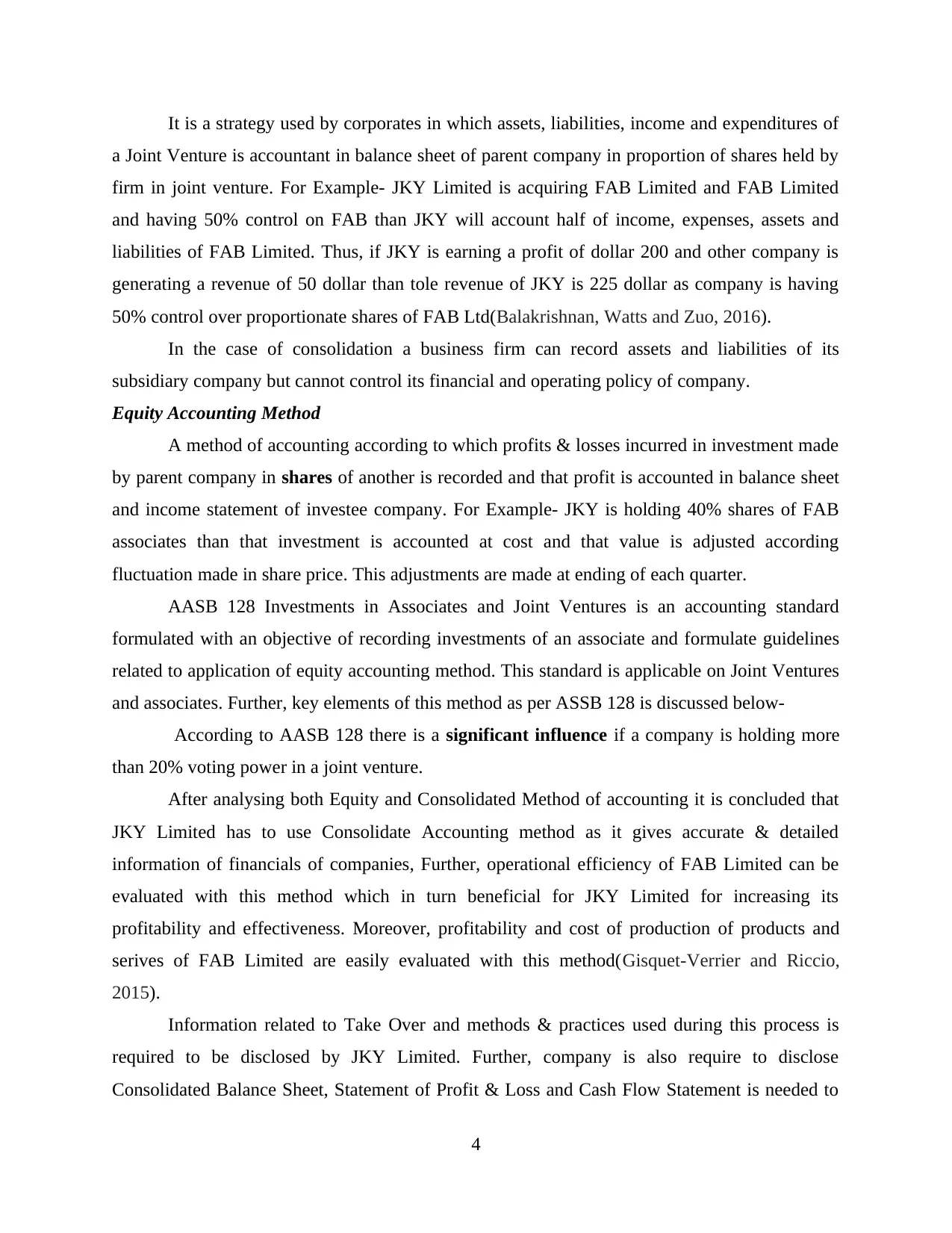
It is a strategy used by corporates in which assets, liabilities, income and expenditures of
a Joint Venture is accountant in balance sheet of parent company in proportion of shares held by
firm in joint venture. For Example- JKY Limited is acquiring FAB Limited and FAB Limited
and having 50% control on FAB than JKY will account half of income, expenses, assets and
liabilities of FAB Limited. Thus, if JKY is earning a profit of dollar 200 and other company is
generating a revenue of 50 dollar than tole revenue of JKY is 225 dollar as company is having
50% control over proportionate shares of FAB Ltd(Balakrishnan, Watts and Zuo, 2016).
In the case of consolidation a business firm can record assets and liabilities of its
subsidiary company but cannot control its financial and operating policy of company.
Equity Accounting Method
A method of accounting according to which profits & losses incurred in investment made
by parent company in shares of another is recorded and that profit is accounted in balance sheet
and income statement of investee company. For Example- JKY is holding 40% shares of FAB
associates than that investment is accounted at cost and that value is adjusted according
fluctuation made in share price. This adjustments are made at ending of each quarter.
AASB 128 Investments in Associates and Joint Ventures is an accounting standard
formulated with an objective of recording investments of an associate and formulate guidelines
related to application of equity accounting method. This standard is applicable on Joint Ventures
and associates. Further, key elements of this method as per ASSB 128 is discussed below-
According to AASB 128 there is a significant influence if a company is holding more
than 20% voting power in a joint venture.
After analysing both Equity and Consolidated Method of accounting it is concluded that
JKY Limited has to use Consolidate Accounting method as it gives accurate & detailed
information of financials of companies, Further, operational efficiency of FAB Limited can be
evaluated with this method which in turn beneficial for JKY Limited for increasing its
profitability and effectiveness. Moreover, profitability and cost of production of products and
serives of FAB Limited are easily evaluated with this method(Gisquet-Verrier and Riccio,
2015).
Information related to Take Over and methods & practices used during this process is
required to be disclosed by JKY Limited. Further, company is also require to disclose
Consolidated Balance Sheet, Statement of Profit & Loss and Cash Flow Statement is needed to
4
a Joint Venture is accountant in balance sheet of parent company in proportion of shares held by
firm in joint venture. For Example- JKY Limited is acquiring FAB Limited and FAB Limited
and having 50% control on FAB than JKY will account half of income, expenses, assets and
liabilities of FAB Limited. Thus, if JKY is earning a profit of dollar 200 and other company is
generating a revenue of 50 dollar than tole revenue of JKY is 225 dollar as company is having
50% control over proportionate shares of FAB Ltd(Balakrishnan, Watts and Zuo, 2016).
In the case of consolidation a business firm can record assets and liabilities of its
subsidiary company but cannot control its financial and operating policy of company.
Equity Accounting Method
A method of accounting according to which profits & losses incurred in investment made
by parent company in shares of another is recorded and that profit is accounted in balance sheet
and income statement of investee company. For Example- JKY is holding 40% shares of FAB
associates than that investment is accounted at cost and that value is adjusted according
fluctuation made in share price. This adjustments are made at ending of each quarter.
AASB 128 Investments in Associates and Joint Ventures is an accounting standard
formulated with an objective of recording investments of an associate and formulate guidelines
related to application of equity accounting method. This standard is applicable on Joint Ventures
and associates. Further, key elements of this method as per ASSB 128 is discussed below-
According to AASB 128 there is a significant influence if a company is holding more
than 20% voting power in a joint venture.
After analysing both Equity and Consolidated Method of accounting it is concluded that
JKY Limited has to use Consolidate Accounting method as it gives accurate & detailed
information of financials of companies, Further, operational efficiency of FAB Limited can be
evaluated with this method which in turn beneficial for JKY Limited for increasing its
profitability and effectiveness. Moreover, profitability and cost of production of products and
serives of FAB Limited are easily evaluated with this method(Gisquet-Verrier and Riccio,
2015).
Information related to Take Over and methods & practices used during this process is
required to be disclosed by JKY Limited. Further, company is also require to disclose
Consolidated Balance Sheet, Statement of Profit & Loss and Cash Flow Statement is needed to
4
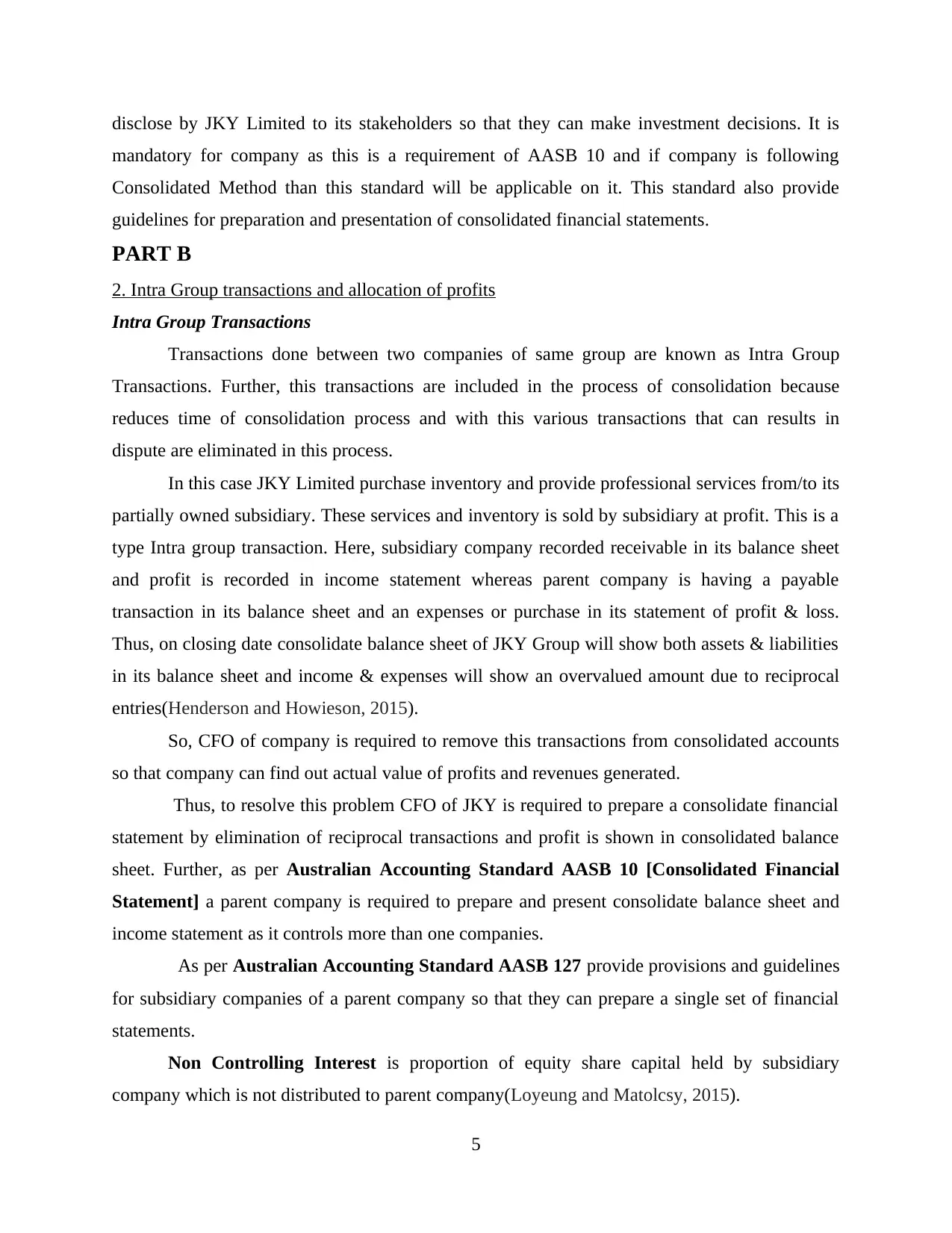
disclose by JKY Limited to its stakeholders so that they can make investment decisions. It is
mandatory for company as this is a requirement of AASB 10 and if company is following
Consolidated Method than this standard will be applicable on it. This standard also provide
guidelines for preparation and presentation of consolidated financial statements.
PART B
2. Intra Group transactions and allocation of profits
Intra Group Transactions
Transactions done between two companies of same group are known as Intra Group
Transactions. Further, this transactions are included in the process of consolidation because
reduces time of consolidation process and with this various transactions that can results in
dispute are eliminated in this process.
In this case JKY Limited purchase inventory and provide professional services from/to its
partially owned subsidiary. These services and inventory is sold by subsidiary at profit. This is a
type Intra group transaction. Here, subsidiary company recorded receivable in its balance sheet
and profit is recorded in income statement whereas parent company is having a payable
transaction in its balance sheet and an expenses or purchase in its statement of profit & loss.
Thus, on closing date consolidate balance sheet of JKY Group will show both assets & liabilities
in its balance sheet and income & expenses will show an overvalued amount due to reciprocal
entries(Henderson and Howieson, 2015).
So, CFO of company is required to remove this transactions from consolidated accounts
so that company can find out actual value of profits and revenues generated.
Thus, to resolve this problem CFO of JKY is required to prepare a consolidate financial
statement by elimination of reciprocal transactions and profit is shown in consolidated balance
sheet. Further, as per Australian Accounting Standard AASB 10 [Consolidated Financial
Statement] a parent company is required to prepare and present consolidate balance sheet and
income statement as it controls more than one companies.
As per Australian Accounting Standard AASB 127 provide provisions and guidelines
for subsidiary companies of a parent company so that they can prepare a single set of financial
statements.
Non Controlling Interest is proportion of equity share capital held by subsidiary
company which is not distributed to parent company(Loyeung and Matolcsy, 2015).
5
mandatory for company as this is a requirement of AASB 10 and if company is following
Consolidated Method than this standard will be applicable on it. This standard also provide
guidelines for preparation and presentation of consolidated financial statements.
PART B
2. Intra Group transactions and allocation of profits
Intra Group Transactions
Transactions done between two companies of same group are known as Intra Group
Transactions. Further, this transactions are included in the process of consolidation because
reduces time of consolidation process and with this various transactions that can results in
dispute are eliminated in this process.
In this case JKY Limited purchase inventory and provide professional services from/to its
partially owned subsidiary. These services and inventory is sold by subsidiary at profit. This is a
type Intra group transaction. Here, subsidiary company recorded receivable in its balance sheet
and profit is recorded in income statement whereas parent company is having a payable
transaction in its balance sheet and an expenses or purchase in its statement of profit & loss.
Thus, on closing date consolidate balance sheet of JKY Group will show both assets & liabilities
in its balance sheet and income & expenses will show an overvalued amount due to reciprocal
entries(Henderson and Howieson, 2015).
So, CFO of company is required to remove this transactions from consolidated accounts
so that company can find out actual value of profits and revenues generated.
Thus, to resolve this problem CFO of JKY is required to prepare a consolidate financial
statement by elimination of reciprocal transactions and profit is shown in consolidated balance
sheet. Further, as per Australian Accounting Standard AASB 10 [Consolidated Financial
Statement] a parent company is required to prepare and present consolidate balance sheet and
income statement as it controls more than one companies.
As per Australian Accounting Standard AASB 127 provide provisions and guidelines
for subsidiary companies of a parent company so that they can prepare a single set of financial
statements.
Non Controlling Interest is proportion of equity share capital held by subsidiary
company which is not distributed to parent company(Loyeung and Matolcsy, 2015).
5
⊘ This is a preview!⊘
Do you want full access?
Subscribe today to unlock all pages.

Trusted by 1+ million students worldwide
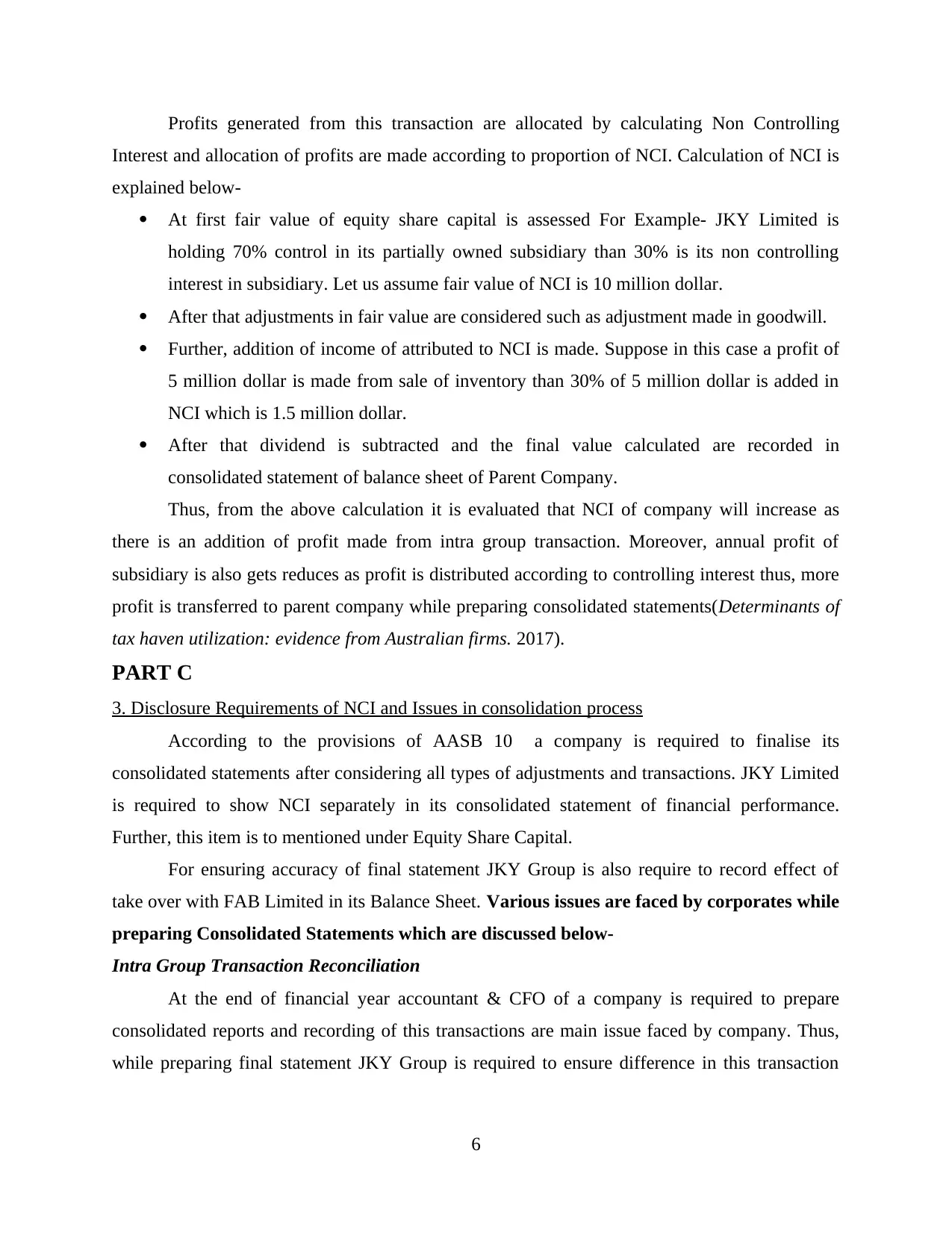
Profits generated from this transaction are allocated by calculating Non Controlling
Interest and allocation of profits are made according to proportion of NCI. Calculation of NCI is
explained below-
At first fair value of equity share capital is assessed For Example- JKY Limited is
holding 70% control in its partially owned subsidiary than 30% is its non controlling
interest in subsidiary. Let us assume fair value of NCI is 10 million dollar.
After that adjustments in fair value are considered such as adjustment made in goodwill.
Further, addition of income of attributed to NCI is made. Suppose in this case a profit of
5 million dollar is made from sale of inventory than 30% of 5 million dollar is added in
NCI which is 1.5 million dollar.
After that dividend is subtracted and the final value calculated are recorded in
consolidated statement of balance sheet of Parent Company.
Thus, from the above calculation it is evaluated that NCI of company will increase as
there is an addition of profit made from intra group transaction. Moreover, annual profit of
subsidiary is also gets reduces as profit is distributed according to controlling interest thus, more
profit is transferred to parent company while preparing consolidated statements(Determinants of
tax haven utilization: evidence from Australian firms. 2017).
PART C
3. Disclosure Requirements of NCI and Issues in consolidation process
According to the provisions of AASB 10 a company is required to finalise its
consolidated statements after considering all types of adjustments and transactions. JKY Limited
is required to show NCI separately in its consolidated statement of financial performance.
Further, this item is to mentioned under Equity Share Capital.
For ensuring accuracy of final statement JKY Group is also require to record effect of
take over with FAB Limited in its Balance Sheet. Various issues are faced by corporates while
preparing Consolidated Statements which are discussed below-
Intra Group Transaction Reconciliation
At the end of financial year accountant & CFO of a company is required to prepare
consolidated reports and recording of this transactions are main issue faced by company. Thus,
while preparing final statement JKY Group is required to ensure difference in this transaction
6
Interest and allocation of profits are made according to proportion of NCI. Calculation of NCI is
explained below-
At first fair value of equity share capital is assessed For Example- JKY Limited is
holding 70% control in its partially owned subsidiary than 30% is its non controlling
interest in subsidiary. Let us assume fair value of NCI is 10 million dollar.
After that adjustments in fair value are considered such as adjustment made in goodwill.
Further, addition of income of attributed to NCI is made. Suppose in this case a profit of
5 million dollar is made from sale of inventory than 30% of 5 million dollar is added in
NCI which is 1.5 million dollar.
After that dividend is subtracted and the final value calculated are recorded in
consolidated statement of balance sheet of Parent Company.
Thus, from the above calculation it is evaluated that NCI of company will increase as
there is an addition of profit made from intra group transaction. Moreover, annual profit of
subsidiary is also gets reduces as profit is distributed according to controlling interest thus, more
profit is transferred to parent company while preparing consolidated statements(Determinants of
tax haven utilization: evidence from Australian firms. 2017).
PART C
3. Disclosure Requirements of NCI and Issues in consolidation process
According to the provisions of AASB 10 a company is required to finalise its
consolidated statements after considering all types of adjustments and transactions. JKY Limited
is required to show NCI separately in its consolidated statement of financial performance.
Further, this item is to mentioned under Equity Share Capital.
For ensuring accuracy of final statement JKY Group is also require to record effect of
take over with FAB Limited in its Balance Sheet. Various issues are faced by corporates while
preparing Consolidated Statements which are discussed below-
Intra Group Transaction Reconciliation
At the end of financial year accountant & CFO of a company is required to prepare
consolidated reports and recording of this transactions are main issue faced by company. Thus,
while preparing final statement JKY Group is required to ensure difference in this transaction
6
Paraphrase This Document
Need a fresh take? Get an instant paraphrase of this document with our AI Paraphraser
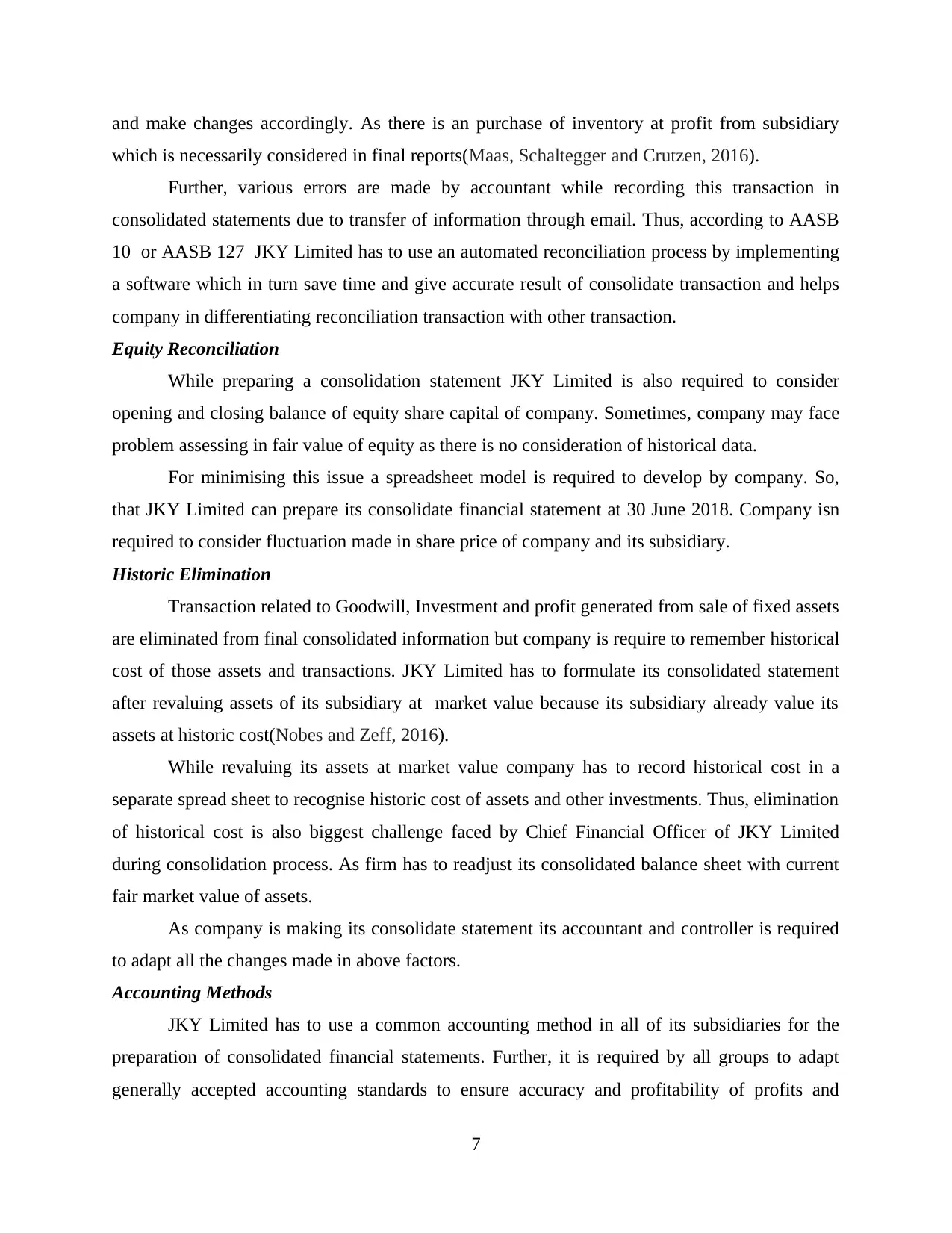
and make changes accordingly. As there is an purchase of inventory at profit from subsidiary
which is necessarily considered in final reports(Maas, Schaltegger and Crutzen, 2016).
Further, various errors are made by accountant while recording this transaction in
consolidated statements due to transfer of information through email. Thus, according to AASB
10 or AASB 127 JKY Limited has to use an automated reconciliation process by implementing
a software which in turn save time and give accurate result of consolidate transaction and helps
company in differentiating reconciliation transaction with other transaction.
Equity Reconciliation
While preparing a consolidation statement JKY Limited is also required to consider
opening and closing balance of equity share capital of company. Sometimes, company may face
problem assessing in fair value of equity as there is no consideration of historical data.
For minimising this issue a spreadsheet model is required to develop by company. So,
that JKY Limited can prepare its consolidate financial statement at 30 June 2018. Company isn
required to consider fluctuation made in share price of company and its subsidiary.
Historic Elimination
Transaction related to Goodwill, Investment and profit generated from sale of fixed assets
are eliminated from final consolidated information but company is require to remember historical
cost of those assets and transactions. JKY Limited has to formulate its consolidated statement
after revaluing assets of its subsidiary at market value because its subsidiary already value its
assets at historic cost(Nobes and Zeff, 2016).
While revaluing its assets at market value company has to record historical cost in a
separate spread sheet to recognise historic cost of assets and other investments. Thus, elimination
of historical cost is also biggest challenge faced by Chief Financial Officer of JKY Limited
during consolidation process. As firm has to readjust its consolidated balance sheet with current
fair market value of assets.
As company is making its consolidate statement its accountant and controller is required
to adapt all the changes made in above factors.
Accounting Methods
JKY Limited has to use a common accounting method in all of its subsidiaries for the
preparation of consolidated financial statements. Further, it is required by all groups to adapt
generally accepted accounting standards to ensure accuracy and profitability of profits and
7
which is necessarily considered in final reports(Maas, Schaltegger and Crutzen, 2016).
Further, various errors are made by accountant while recording this transaction in
consolidated statements due to transfer of information through email. Thus, according to AASB
10 or AASB 127 JKY Limited has to use an automated reconciliation process by implementing
a software which in turn save time and give accurate result of consolidate transaction and helps
company in differentiating reconciliation transaction with other transaction.
Equity Reconciliation
While preparing a consolidation statement JKY Limited is also required to consider
opening and closing balance of equity share capital of company. Sometimes, company may face
problem assessing in fair value of equity as there is no consideration of historical data.
For minimising this issue a spreadsheet model is required to develop by company. So,
that JKY Limited can prepare its consolidate financial statement at 30 June 2018. Company isn
required to consider fluctuation made in share price of company and its subsidiary.
Historic Elimination
Transaction related to Goodwill, Investment and profit generated from sale of fixed assets
are eliminated from final consolidated information but company is require to remember historical
cost of those assets and transactions. JKY Limited has to formulate its consolidated statement
after revaluing assets of its subsidiary at market value because its subsidiary already value its
assets at historic cost(Nobes and Zeff, 2016).
While revaluing its assets at market value company has to record historical cost in a
separate spread sheet to recognise historic cost of assets and other investments. Thus, elimination
of historical cost is also biggest challenge faced by Chief Financial Officer of JKY Limited
during consolidation process. As firm has to readjust its consolidated balance sheet with current
fair market value of assets.
As company is making its consolidate statement its accountant and controller is required
to adapt all the changes made in above factors.
Accounting Methods
JKY Limited has to use a common accounting method in all of its subsidiaries for the
preparation of consolidated financial statements. Further, it is required by all groups to adapt
generally accepted accounting standards to ensure accuracy and profitability of profits and
7
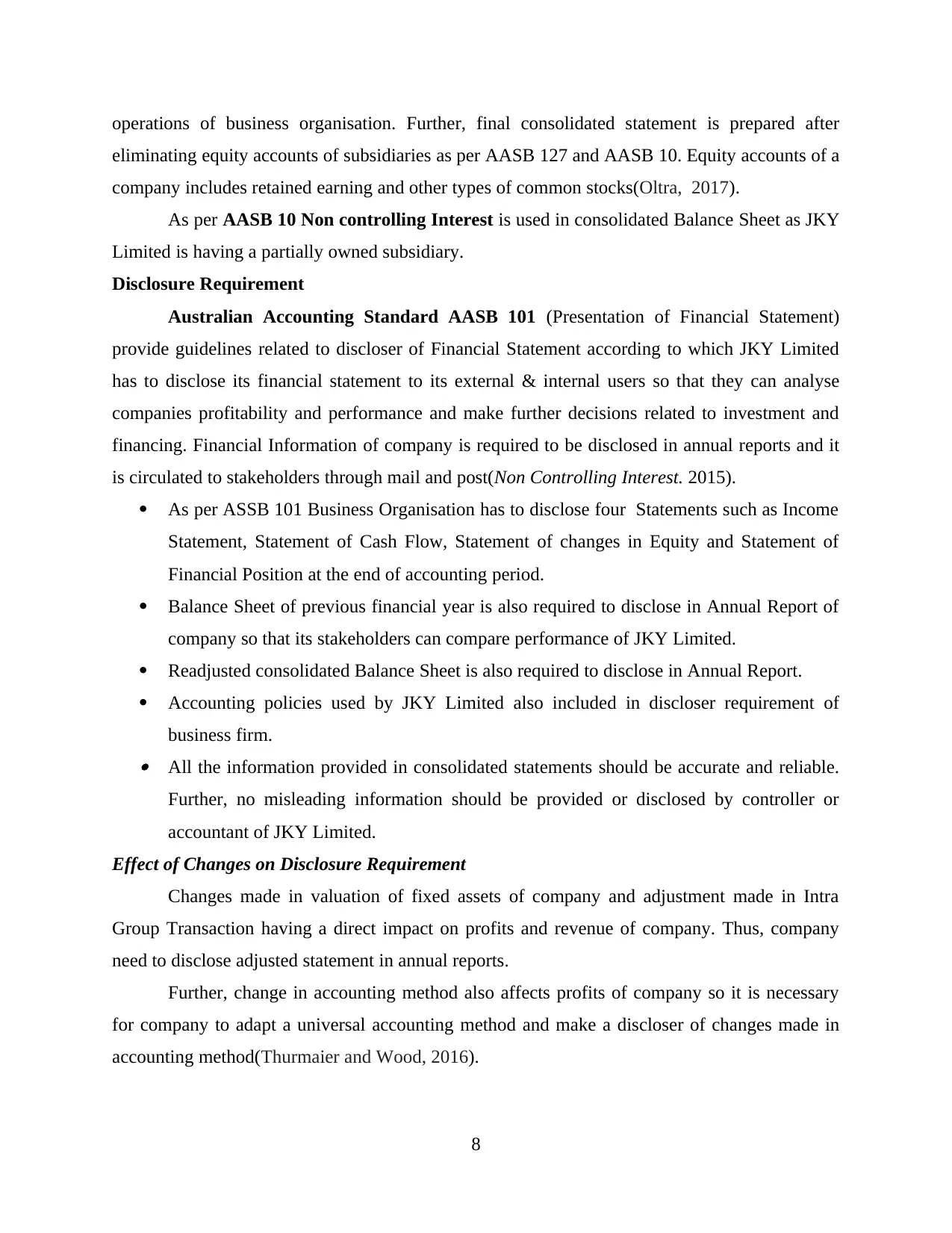
operations of business organisation. Further, final consolidated statement is prepared after
eliminating equity accounts of subsidiaries as per AASB 127 and AASB 10. Equity accounts of a
company includes retained earning and other types of common stocks(Oltra, 2017).
As per AASB 10 Non controlling Interest is used in consolidated Balance Sheet as JKY
Limited is having a partially owned subsidiary.
Disclosure Requirement
Australian Accounting Standard AASB 101 (Presentation of Financial Statement)
provide guidelines related to discloser of Financial Statement according to which JKY Limited
has to disclose its financial statement to its external & internal users so that they can analyse
companies profitability and performance and make further decisions related to investment and
financing. Financial Information of company is required to be disclosed in annual reports and it
is circulated to stakeholders through mail and post(Non Controlling Interest. 2015).
As per ASSB 101 Business Organisation has to disclose four Statements such as Income
Statement, Statement of Cash Flow, Statement of changes in Equity and Statement of
Financial Position at the end of accounting period.
Balance Sheet of previous financial year is also required to disclose in Annual Report of
company so that its stakeholders can compare performance of JKY Limited.
Readjusted consolidated Balance Sheet is also required to disclose in Annual Report.
Accounting policies used by JKY Limited also included in discloser requirement of
business firm. All the information provided in consolidated statements should be accurate and reliable.
Further, no misleading information should be provided or disclosed by controller or
accountant of JKY Limited.
Effect of Changes on Disclosure Requirement
Changes made in valuation of fixed assets of company and adjustment made in Intra
Group Transaction having a direct impact on profits and revenue of company. Thus, company
need to disclose adjusted statement in annual reports.
Further, change in accounting method also affects profits of company so it is necessary
for company to adapt a universal accounting method and make a discloser of changes made in
accounting method(Thurmaier and Wood, 2016).
8
eliminating equity accounts of subsidiaries as per AASB 127 and AASB 10. Equity accounts of a
company includes retained earning and other types of common stocks(Oltra, 2017).
As per AASB 10 Non controlling Interest is used in consolidated Balance Sheet as JKY
Limited is having a partially owned subsidiary.
Disclosure Requirement
Australian Accounting Standard AASB 101 (Presentation of Financial Statement)
provide guidelines related to discloser of Financial Statement according to which JKY Limited
has to disclose its financial statement to its external & internal users so that they can analyse
companies profitability and performance and make further decisions related to investment and
financing. Financial Information of company is required to be disclosed in annual reports and it
is circulated to stakeholders through mail and post(Non Controlling Interest. 2015).
As per ASSB 101 Business Organisation has to disclose four Statements such as Income
Statement, Statement of Cash Flow, Statement of changes in Equity and Statement of
Financial Position at the end of accounting period.
Balance Sheet of previous financial year is also required to disclose in Annual Report of
company so that its stakeholders can compare performance of JKY Limited.
Readjusted consolidated Balance Sheet is also required to disclose in Annual Report.
Accounting policies used by JKY Limited also included in discloser requirement of
business firm. All the information provided in consolidated statements should be accurate and reliable.
Further, no misleading information should be provided or disclosed by controller or
accountant of JKY Limited.
Effect of Changes on Disclosure Requirement
Changes made in valuation of fixed assets of company and adjustment made in Intra
Group Transaction having a direct impact on profits and revenue of company. Thus, company
need to disclose adjusted statement in annual reports.
Further, change in accounting method also affects profits of company so it is necessary
for company to adapt a universal accounting method and make a discloser of changes made in
accounting method(Thurmaier and Wood, 2016).
8
⊘ This is a preview!⊘
Do you want full access?
Subscribe today to unlock all pages.

Trusted by 1+ million students worldwide
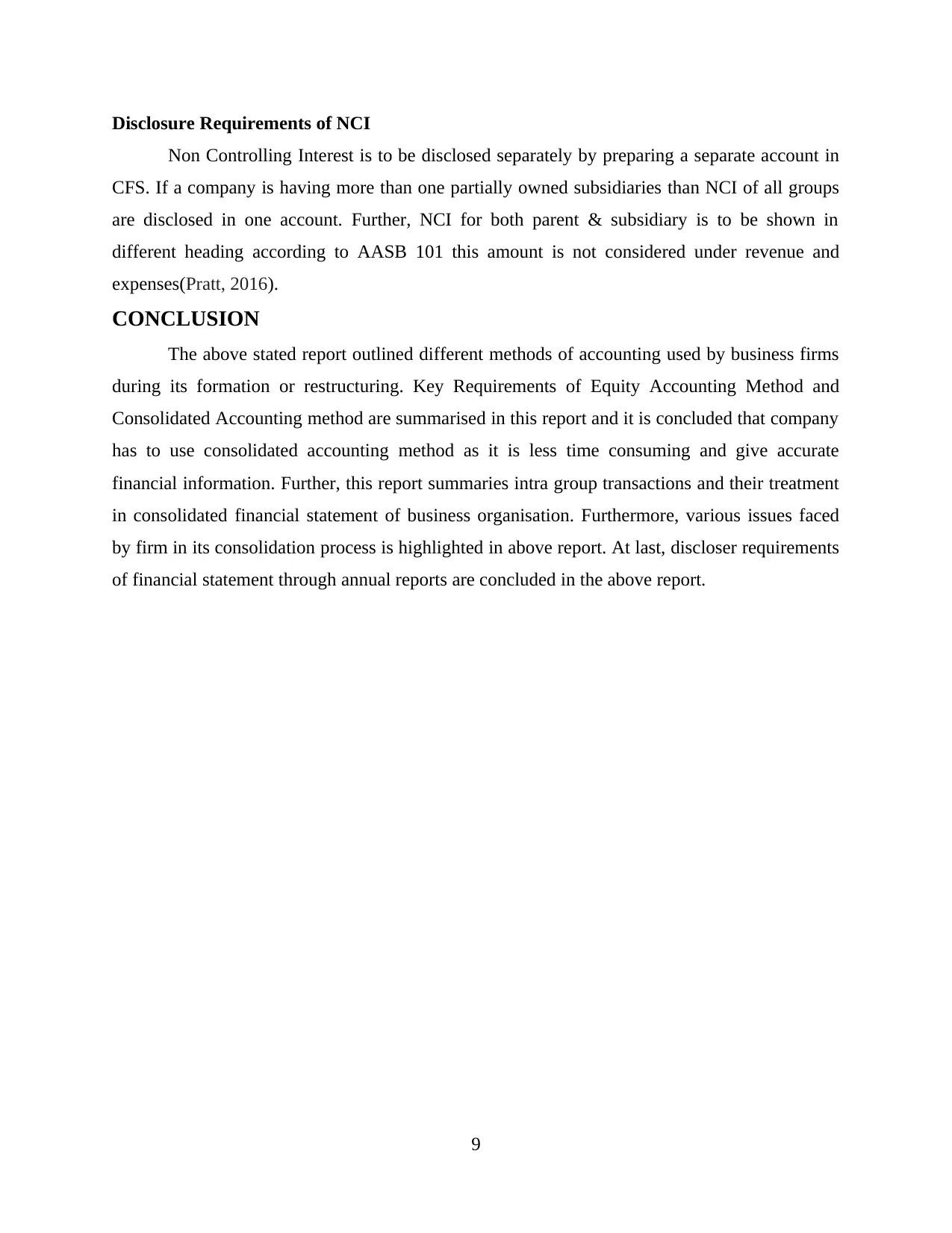
Disclosure Requirements of NCI
Non Controlling Interest is to be disclosed separately by preparing a separate account in
CFS. If a company is having more than one partially owned subsidiaries than NCI of all groups
are disclosed in one account. Further, NCI for both parent & subsidiary is to be shown in
different heading according to AASB 101 this amount is not considered under revenue and
expenses(Pratt, 2016).
CONCLUSION
The above stated report outlined different methods of accounting used by business firms
during its formation or restructuring. Key Requirements of Equity Accounting Method and
Consolidated Accounting method are summarised in this report and it is concluded that company
has to use consolidated accounting method as it is less time consuming and give accurate
financial information. Further, this report summaries intra group transactions and their treatment
in consolidated financial statement of business organisation. Furthermore, various issues faced
by firm in its consolidation process is highlighted in above report. At last, discloser requirements
of financial statement through annual reports are concluded in the above report.
9
Non Controlling Interest is to be disclosed separately by preparing a separate account in
CFS. If a company is having more than one partially owned subsidiaries than NCI of all groups
are disclosed in one account. Further, NCI for both parent & subsidiary is to be shown in
different heading according to AASB 101 this amount is not considered under revenue and
expenses(Pratt, 2016).
CONCLUSION
The above stated report outlined different methods of accounting used by business firms
during its formation or restructuring. Key Requirements of Equity Accounting Method and
Consolidated Accounting method are summarised in this report and it is concluded that company
has to use consolidated accounting method as it is less time consuming and give accurate
financial information. Further, this report summaries intra group transactions and their treatment
in consolidated financial statement of business organisation. Furthermore, various issues faced
by firm in its consolidation process is highlighted in above report. At last, discloser requirements
of financial statement through annual reports are concluded in the above report.
9
Paraphrase This Document
Need a fresh take? Get an instant paraphrase of this document with our AI Paraphraser
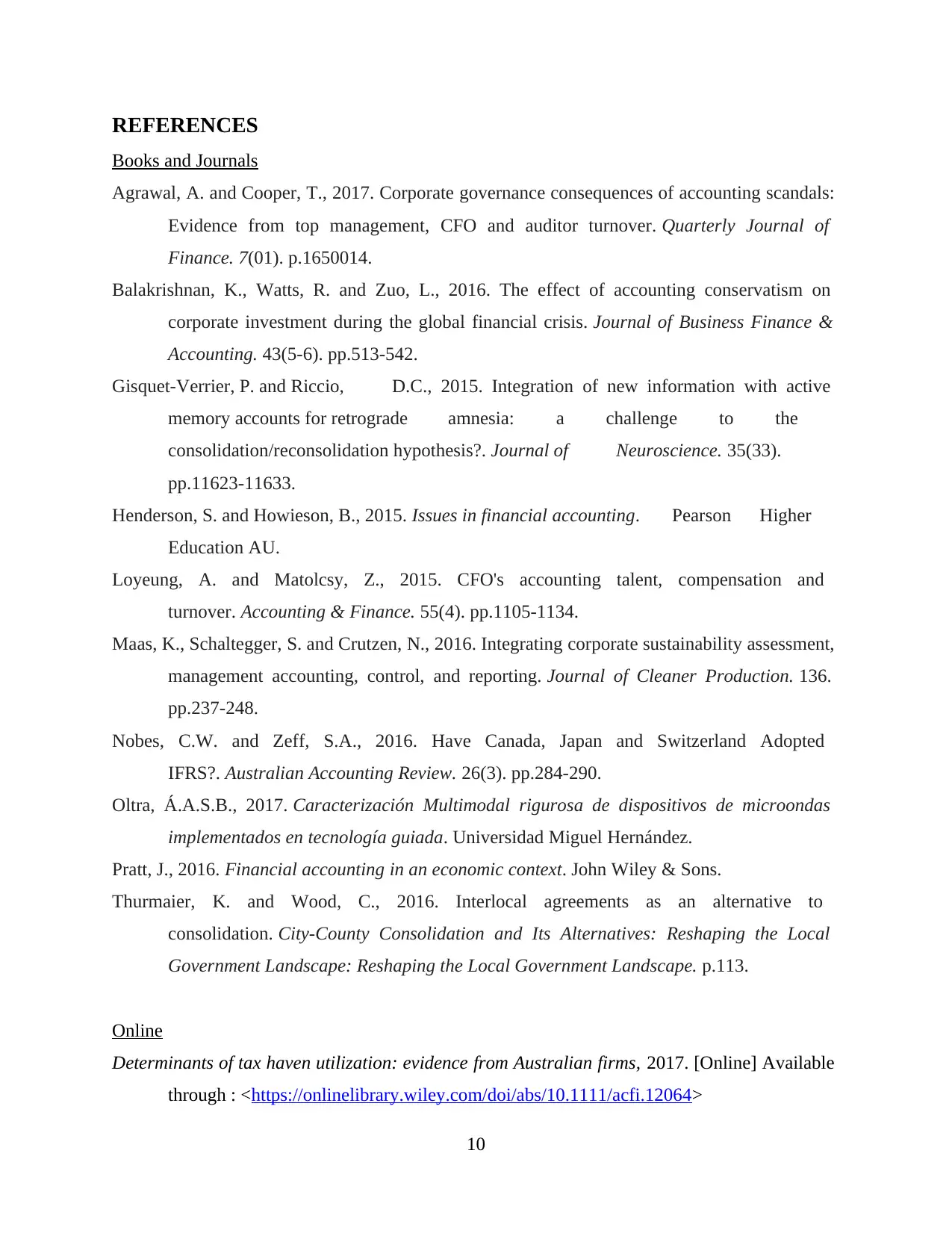
REFERENCES
Books and Journals
Agrawal, A. and Cooper, T., 2017. Corporate governance consequences of accounting scandals:
Evidence from top management, CFO and auditor turnover. Quarterly Journal of
Finance. 7(01). p.1650014.
Balakrishnan, K., Watts, R. and Zuo, L., 2016. The effect of accounting conservatism on
corporate investment during the global financial crisis. Journal of Business Finance &
Accounting. 43(5-6). pp.513-542.
Gisquet-Verrier, P. and Riccio, D.C., 2015. Integration of new information with active
memory accounts for retrograde amnesia: a challenge to the
consolidation/reconsolidation hypothesis?. Journal of Neuroscience. 35(33).
pp.11623-11633.
Henderson, S. and Howieson, B., 2015. Issues in financial accounting. Pearson Higher
Education AU.
Loyeung, A. and Matolcsy, Z., 2015. CFO's accounting talent, compensation and
turnover. Accounting & Finance. 55(4). pp.1105-1134.
Maas, K., Schaltegger, S. and Crutzen, N., 2016. Integrating corporate sustainability assessment,
management accounting, control, and reporting. Journal of Cleaner Production. 136.
pp.237-248.
Nobes, C.W. and Zeff, S.A., 2016. Have Canada, Japan and Switzerland Adopted
IFRS?. Australian Accounting Review. 26(3). pp.284-290.
Oltra, Á.A.S.B., 2017. Caracterización Multimodal rigurosa de dispositivos de microondas
implementados en tecnología guiada. Universidad Miguel Hernández.
Pratt, J., 2016. Financial accounting in an economic context. John Wiley & Sons.
Thurmaier, K. and Wood, C., 2016. Interlocal agreements as an alternative to
consolidation. City-County Consolidation and Its Alternatives: Reshaping the Local
Government Landscape: Reshaping the Local Government Landscape. p.113.
Online
Determinants of tax haven utilization: evidence from Australian firms, 2017. [Online] Available
through : <https://onlinelibrary.wiley.com/doi/abs/10.1111/acfi.12064>
10
Books and Journals
Agrawal, A. and Cooper, T., 2017. Corporate governance consequences of accounting scandals:
Evidence from top management, CFO and auditor turnover. Quarterly Journal of
Finance. 7(01). p.1650014.
Balakrishnan, K., Watts, R. and Zuo, L., 2016. The effect of accounting conservatism on
corporate investment during the global financial crisis. Journal of Business Finance &
Accounting. 43(5-6). pp.513-542.
Gisquet-Verrier, P. and Riccio, D.C., 2015. Integration of new information with active
memory accounts for retrograde amnesia: a challenge to the
consolidation/reconsolidation hypothesis?. Journal of Neuroscience. 35(33).
pp.11623-11633.
Henderson, S. and Howieson, B., 2015. Issues in financial accounting. Pearson Higher
Education AU.
Loyeung, A. and Matolcsy, Z., 2015. CFO's accounting talent, compensation and
turnover. Accounting & Finance. 55(4). pp.1105-1134.
Maas, K., Schaltegger, S. and Crutzen, N., 2016. Integrating corporate sustainability assessment,
management accounting, control, and reporting. Journal of Cleaner Production. 136.
pp.237-248.
Nobes, C.W. and Zeff, S.A., 2016. Have Canada, Japan and Switzerland Adopted
IFRS?. Australian Accounting Review. 26(3). pp.284-290.
Oltra, Á.A.S.B., 2017. Caracterización Multimodal rigurosa de dispositivos de microondas
implementados en tecnología guiada. Universidad Miguel Hernández.
Pratt, J., 2016. Financial accounting in an economic context. John Wiley & Sons.
Thurmaier, K. and Wood, C., 2016. Interlocal agreements as an alternative to
consolidation. City-County Consolidation and Its Alternatives: Reshaping the Local
Government Landscape: Reshaping the Local Government Landscape. p.113.
Online
Determinants of tax haven utilization: evidence from Australian firms, 2017. [Online] Available
through : <https://onlinelibrary.wiley.com/doi/abs/10.1111/acfi.12064>
10

Non Controlling Interest, 2015. [Online] Available through:
<https://acta.mendelu.cz/64/1/0275/>
11
<https://acta.mendelu.cz/64/1/0275/>
11
⊘ This is a preview!⊘
Do you want full access?
Subscribe today to unlock all pages.

Trusted by 1+ million students worldwide
1 out of 12
Related Documents
Your All-in-One AI-Powered Toolkit for Academic Success.
+13062052269
info@desklib.com
Available 24*7 on WhatsApp / Email
![[object Object]](/_next/static/media/star-bottom.7253800d.svg)
Unlock your academic potential
Copyright © 2020–2025 A2Z Services. All Rights Reserved. Developed and managed by ZUCOL.





